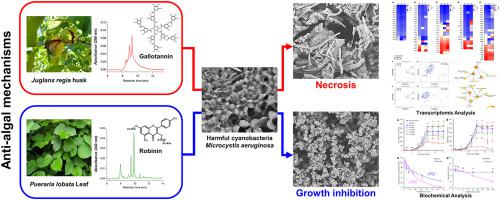Chemosphere ( IF 8.1 ) Pub Date : 2023-02-25 , DOI: 10.1016/j.chemosphere.2023.138202 Chan Saem Gil , Seok Hyun Eom

|
Phytochemical is considered an alternative method for cyanobacterial bloom control in aquatic environments. When cyanobacteria are treated with anti-algal materials produced from plant tissues, they tend to exhibit growth inhibition or necrosis of cells. These different anti-algal responses have not been well discussed, and thus, the modes of anti-algal action in cyanobacteria remain obscure. In this study, transcriptomic and biochemical researches were conducted to understand the mechanisms of cyanobacterial growth inhibition and necrosis in harmful cyanobacterial cells exposed to allelopathic materials. The cyanobacteria Microcystis aeruginosa was treated with aqueous extracts of walnut husk, rose leaf, and kudzu leaf. Walnut husk and rose leaf extracts induced mortality of cyanobacterial population with cell necrosis, whereas kudzu leaf extract exhibited poorly grown cells with shrunk size. Through RNA sequencing, it was revealed that the necrotic extracts significantly downregulated critical genes in enzymatic chain reactions for carbohydrate assembly in the carbon fixation cycle and peptidoglycan synthesis. Compared to the necrotic extract treatment, expression of several genes related to DNA repair, carbon fixation, and cell reproduction was less interrupted by the kudzu leaf extract. Biochemical analysis of cyanobacterial regrowth was performed using gallotannin and robinin. Gallotannin was identified as the major anti-algal compound in walnut husk and rose leaf affecting cyanobacterial necrosis, whereas robinin, which is the typical chemical in kudzu leaf, was associated with growth inhibition of cyanobacterial cells. These combinational studies using RNA sequencing and regrowth assays provided evidence supporting the allelopathic effects of plant-derived materials on cyanobacterial control. Furthermore, our findings suggest novel algicidal scenarios with different responses in the cyanobacterial cells depending on the type of anti-algal compounds.
中文翻译:

知更鸟或富含单宁的植物对铜绿微囊藻的两种不同的抗藻控制机制
植物化学物质被认为是水生环境中蓝藻水华控制的替代方法。当用植物组织产生的抗藻材料处理蓝藻时,它们往往会表现出生长抑制或细胞坏死。这些不同的抗藻反应尚未得到很好的讨论,因此,蓝藻中的抗藻作用模式仍然不清楚。在这项研究中,进行了转录组学和生化研究,以了解暴露于化感物质的有害蓝藻细胞中蓝藻生长抑制和坏死的机制。蓝藻微囊藻用核桃壳、玫瑰叶和野葛叶的水提取物处理。核桃壳和玫瑰叶提取物导致细胞坏死的蓝藻种群死亡,而葛根叶提取物则表现出生长不良且体积缩小的细胞。通过 RNA 测序,发现坏死提取物显着下调了碳固定循环和肽聚糖合成中碳水化合物组装的酶链反应中的关键基因。与坏死提取物处理相比,葛根叶提取物较少中断与 DNA 修复、碳固定和细胞繁殖相关的几种基因的表达。使用没食子单宁和知更鸟进行蓝藻再生的生化分析。Gallotannin 被确定为核桃壳和玫瑰叶中影响蓝藻坏死的主要抗藻化合物,而刺槐宁是野葛叶中的典型化学物质,与蓝藻细胞的生长抑制有关。这些使用 RNA 测序和再生测定的组合研究提供了支持植物来源材料对蓝藻控制的化感作用的证据。此外,我们的研究结果表明,根据抗藻化合物的类型,蓝藻细胞中具有不同反应的新型杀藻情景。这些使用 RNA 测序和再生测定的组合研究提供了支持植物来源材料对蓝藻控制的化感作用的证据。此外,我们的研究结果表明,根据抗藻化合物的类型,蓝藻细胞中具有不同反应的新型杀藻情景。这些使用 RNA 测序和再生测定的组合研究提供了支持植物来源材料对蓝藻控制的化感作用的证据。此外,我们的研究结果表明,根据抗藻化合物的类型,蓝藻细胞中具有不同反应的新型杀藻情景。































 京公网安备 11010802027423号
京公网安备 11010802027423号